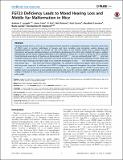FGF23 Deficiency Leads to Mixed Hearing Loss and Middle Ear Malformation in Mice

View/
Author
Lysaght, Andrew C.
Yuan, Quan
Kalwani, Neil
Cunnane, MaryBeth
Published Version
https://doi.org/10.1371/journal.pone.0107681Metadata
Show full item recordCitation
Lysaght, Andrew C., Quan Yuan, Yi Fan, Neil Kalwani, Paul Caruso, MaryBeth Cunnane, Beate Lanske, and Konstantina M. Stanković. 2014. “FGF23 Deficiency Leads to Mixed Hearing Loss and Middle Ear Malformation in Mice.” PLoS ONE 9 (9): e107681. doi:10.1371/journal.pone.0107681. http://dx.doi.org/10.1371/journal.pone.0107681.Abstract
Fibroblast growth factor 23 (FGF23) is a circulating hormone important in phosphate homeostasis. Abnormal serum levels of FGF23 result in systemic pathologies in humans and mice, including renal phosphate wasting diseases and hyperphosphatemia. We sought to uncover the role FGF23 plays in the auditory system due to shared molecular mechanisms and genetic pathways between ear and kidney development, the critical roles multiple FGFs play in auditory development and the known hearing phenotype in mice deficient in klotho (KL), a critical co-factor for FGF23 signaling. Using functional assessments of hearing, we demonstrate that Fgf mice are profoundly deaf. Fgf mice have moderate hearing loss above 20 kHz, consistent with mixed conductive and sensorineural pathology of both middle and inner ear origin. Histology and high-voltage X-ray computed tomography of Fgf mice demonstrate dysplastic bulla and ossicles; Fgf mice have near-normal morphology. The cochleae of mutant mice appear nearly normal on gross and microscopic inspection. In wild type mice, FGF23 is ubiquitously expressed throughout the cochlea. Measurements from Fgf mice do not match the auditory phenotype of Kl−/− mice, suggesting that loss of FGF23 activity impacts the auditory system via mechanisms at least partially independent of KL. Given the extensive middle ear malformations and the overlap of initiation of FGF23 activity and Eustachian tube development, this work suggests a possible role for FGF23 in otitis media.Other Sources
http://www.ncbi.nlm.nih.gov/pmc/articles/PMC4171482/pdf/Terms of Use
This article is made available under the terms and conditions applicable to Other Posted Material, as set forth at http://nrs.harvard.edu/urn-3:HUL.InstRepos:dash.current.terms-of-use#LAACitable link to this page
http://nrs.harvard.edu/urn-3:HUL.InstRepos:12987347
Collections
- HMS Scholarly Articles [17922]
Contact administrator regarding this item (to report mistakes or request changes)


